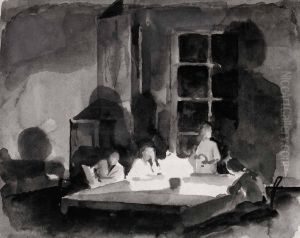Nikolai N. Kupryanov Paintings
Nikolai Nikolaevich Kupryanov was a notable Russian artist, born in 1903. His artistic journey began in an era of significant upheaval and transformation, not just in Russia, but around the world. The early 20th century was a period marked by revolutions, the emergence of avant-garde art movements, and the dramatic shifts in the socio-political landscape following the Russian Revolution of 1917. Kupryanov's work was deeply influenced by these turbulent times, reflecting the complexities and challenges of the era.
Kupryanov's art cannot be easily categorized into a single style or movement. His oeuvre includes elements of realism, impressionism, and elements of the avant-garde. Despite the diversity in his style, his works often carried a distinctive Russian character, capturing the essence of Russian life, landscapes, and the spirit of its people. His ability to convey the depth of human emotions and the subtleties of social commentary through his art made him a significant figure in Russian art history.
Tragically, Kupryanov's life and career were cut short when he died in 1933, at the age of 30. His death marked the loss of a promising talent who had the potential to contribute even more to the world of art. Despite his brief career, Kupryanov left behind a legacy that continues to be celebrated and studied by art historians and enthusiasts. His works are preserved in various museums and collections, serving as a testament to his artistic vision and the turbulent era that shaped his creative output.
Kupryanov's biography is a reflection of a young artist navigating the complexities of early 20th-century Russia, capturing its beauty and contradictions through his art. His life story is a poignant reminder of the impact of historical events on individual lives and the enduring power of art to reflect and transcend its time.
